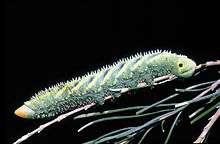Coequosa triangularis
| Coequosa triangularis | |
|---|---|
 | |
 | |
| Caterpillar of Coequosa triangularis | |
| Scientific classification | |
| Kingdom: | Animalia |
| Phylum: | Arthropoda |
| Class: | Insecta |
| Order: | Lepidoptera |
| Family: | Sphingidae |
| Genus: | Coequosa |
| Species: | C. triangularis |
| Binomial name | |
| Coequosa triangularis (Donovan, 1805)[1] | |
| Synonyms | |
| |
The double haded hawk moth (Coequosa triangularis) is a species of moth of the Sphingidae family. It is known from New South Wales and Queensland in Australia.
The wingspan is about 130 mm, making it Australia's largest hawk moth. Adults are yellow and brown with broad wavy markings.[2]
The larvae feed on Banksia ericifolia, Grevillea robusta, Hakea dactyloides, Macadamia integrifolia, Persoonia levis and Stenocarpus sinuatus. The head is an orange conical structure, but on its tail are two large raised black knobs. These look like a pair of large eyes, so that an observer or predator finds it difficult to determine which end is the head. The body is green or yellow, often with yellow diagonal stripes and sometimes with purplish lateral markings. It is covered in soft short pale spines. Full-grown larvae are about 100 mm long.
References
| Wikimedia Commons has media related to Coequosa triangularis. |
- ↑ "CATE Creating a Taxonomic eScience - Sphingidae". Cate-sphingidae.org. Retrieved 2011-11-01.
- ↑ "Australian Insects". Lepidoptera.butterflyhouse.com.au. Retrieved 2011-11-01.